Path through the Pyramid
Part 5
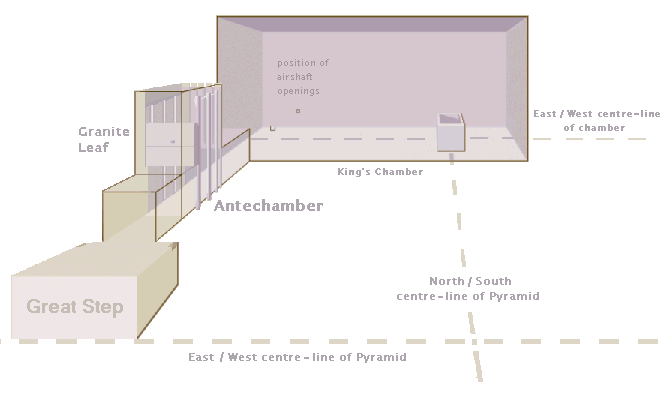
The Upper Chamber and Passage
If we were to draw a line to the right, exactly 286.1 Pins from the base and centre of the Great Step's riser, it would end directly below the apex of the Pyramid around the level of the fiftieth course of masonry. Before entering the low passage that leads to the uppermost chamber the visitor must therefore first climb up and over the Pyramid's east-west axis in the form of the Great Step. At 35.76 Pyramid inches high, it is exactly one-eighth of 286.1 and one-tenth of search number 358.1
The large chamber at the end of the complex called the King's Chamber is reached through a succession of low and high portions: a short low section of nearly four and a half feet (1.3m), a raised central section of nine and a half feet (3m), and a second low section of eight and a half feet (2.5m). Overall length from the Great Step to the south wall of the upper chamber is close to forty-five feet (14m). In outline the chamber complex shows a passing resemblance to the longer subterranean system, but in fact there is no comparison for the King's Chamber Complex, with some puzzling omissions, is the most finished of the three Pyramid chambers.2
The raised middle section is referred to as the Antechamber. Here the roof level rises sharply from 41.2 Pyramid inches in the first low passageway to 149.44, until an overhanging ledge called the 'Granite Leaf' forces the visitor to stoop again to pass under it, but not before he notices a change of masonry halfway between the north wall and the Leaf. From limestone it changes to granite and remains granite from thereon except for the topmost section of the Antechamber's south wall.
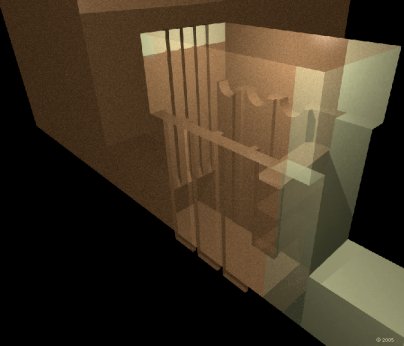
On the north side of the Leaf, a protruding one-Pin seal or boss has been left by the men who
worked on the Pyramid, offset by one Pyramid inch to the west of the Leaf's centre. Between the
east side of the Leaf rebate and the centre-line of the boss is that same precise measurement of 25
Pyramid inches: Let there be
. Beyond the Granite Leaf three pilasters divide
the wainscoting on the east and west walls of the Antechamber, the wainscot being higher on the west
side. Above the entrance to the second low passage, four vertical grooves taper to an end,
dividing the south wall of the Antechamber into five parts.
At the end of the second low passage we come to the last chamber of the Pyramid, a large room made out of granite blocks that has been subjected to damage from earthquake or settlement during its past. It houses a coffer made from the same enduring granite, without lid and of rough finish.3
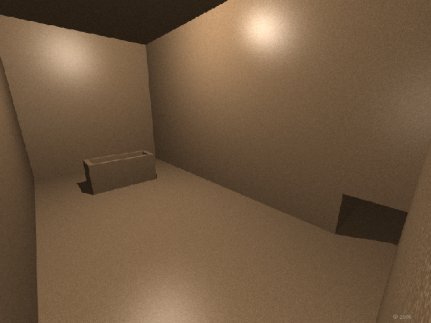
The coffer is believed to have been originally sited centrally lengthwise along the north-south axis of the pyramid, bisected by the east-west axis of the chamber and for the following exploration this will be assumed as its correct position.
The Earth Year
Search number 365.24
Osiris appears, the Sceptre is pure, the Lord of Right is exalted at the First of the Year, (even he) the Lord of the Year.
Pyramid texts: Utterance 577
For pyramidologists it is a well-accepted fact that much of the chamber and its passage is founded on pi and the number 365.24, an unmistakable reference to Earth in relation to the sun.
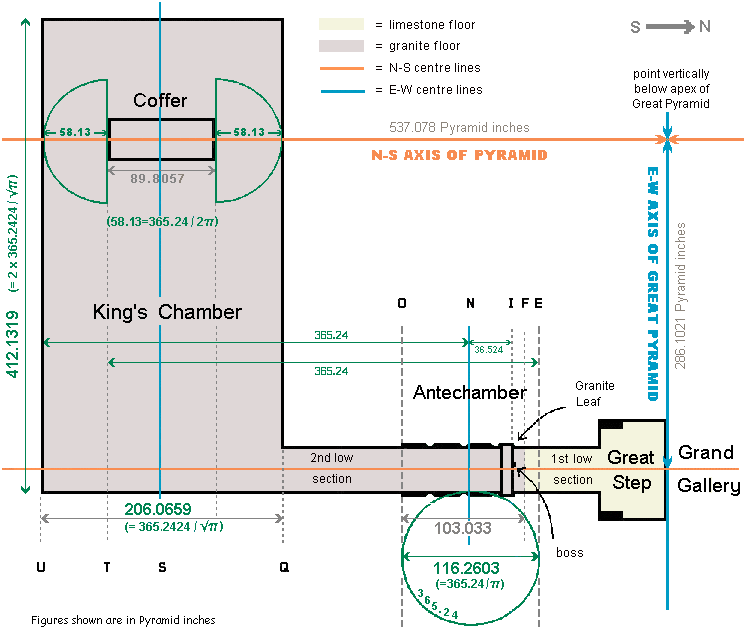
River the second
To find out more about this number we should look in Genesis. Since biblical gematria works only
with whole numbers we look for the rounded-down 365, which first appears as the
second
in chapter 2 (verse 13c) where it describes one of the four rivers that surround
the Garden of Eden:
And the name of the river the second is Gihon, that which is surrounding all the land of Cush
Genesis 2:13
Cush (Kush) is an old name for southern Egypt, and here we see Hebrew text corresponding with what is known of the Egyptian calendar believed to be a year of 365 days and based partly on the annual flooding of the Nile. The gematria appears to identify the River Gihon as the Nile. The number is clearly an important pyramid standard.4
Texts from the Upper Chamber
At this culmination of the Pyramid's interior all we can do is observe the gematria within the masonry context. Between the Great Step and south wall of the King's Chamber a large variety of north-to-south measurements can be extracted from the different reference and halfway points. First-occurrence gematria associated with the main features are shown below.
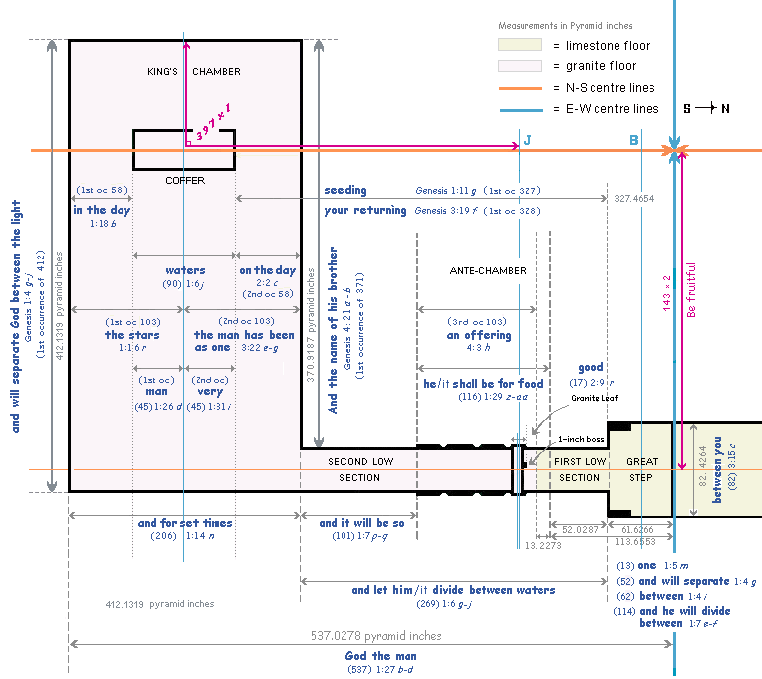
King's Chamber standard numbers
Introducing 397
"and everything which will call to him the man soul of life that be his name" Genesis 2:19 t-bb (Gematria, HJE)
All standard numbers representing Hebrew names for God are present in this complex. In a rare appearance of 397, the signifier carrying the personal name of the king rises from the chamber's western horizon as the last prime before the final Hebrew letter Tav. Passing through the coffer and taking a right-angled turn at its centre, it then progresses northwards along the central north-south axis of the Pyramid.5
The Coffer
Our journey ends at the granite coffer in the King's Chamber where the gematria speaks of a shared humanity. The missing corner on the coffer is a result of damage sustained in the past.
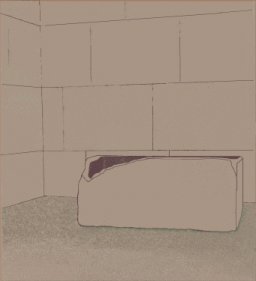
Earlier in this chapter we walked into the King's Chamber and then we stood centrally at the east side of the coffer. Here we can look down and, although it has no lid, we wonder for whom it was intended, and what might have been written on the lid if it had one. The coffer is 38.7 Pins wide, equivalent to a gematria of 39 (13 x 3). We find this number is emphasised by occurring only as 'a-khi-cha' and being repeated three times over the three successive verses. Gen.4:9, 10, 11 This word is translated as
HJE: The Stone, Chapter 10thy brother. The referent in 'thy' is Cain who killed his brother. (Cf. Osiris who was killed by his brother.)
The journey back
The coffer ends the tour of the Pyramid's interior. Our journey back through the aperture at the bottom of the Grand Gallery brings us to the mouth of the Well-Shaft.
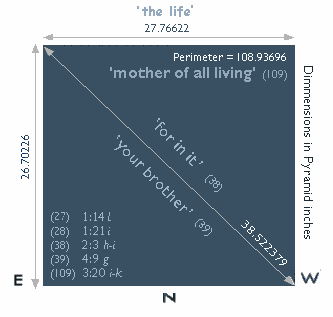
A descent of nearly 200 feet (61m) takes us through the Well-Shaft and Grotto to the tunnel that exits at the bottom of the Descending Passage.
Final part in Part 6: Return to the present
Footnotes
1
Rutherford's observations on the Great Step.
Diagram 2
2
Egyptologist Sir Flinders Petrie finds much in the Great Pyramid to admire, but makes the following
comments on the Antechamber's masonry…
"Coming now to details of the walls, the rough and coarse workmanship is astonishing, in comparison with the exquisite masonry of the casing and entrance of the Pyramid; and the main object in giving the following details is to show how badly pyramid masons could work"
…later the floor of the King's Chamber and passage:
It appears, then, that the floor never was plane or regular; and that, in this respect, it shared the character of the very variable floor of the passage that led to the chamber, no two stones of which are on the same level. The passage floor, even out to the great step in the gallery, is also inserted between the walls, like the floor of the chamber.
The Pyramids and Temples of Gizeh
Chap.7. Inside of Great Pyramid
3
Petrie begins his description of the coffer with these words,
It is not finely wrought, and cannot in this respect rival the coffer in the Second Pyramid.
The Pyramids and Temples of Gizeh; Chap.7.
Inside of Great Pyramid
4
Other biblical texts, which may tell more about the number.
Table 3. Texts with 365
5
A note on the KC standard numbers.
Diagram 3